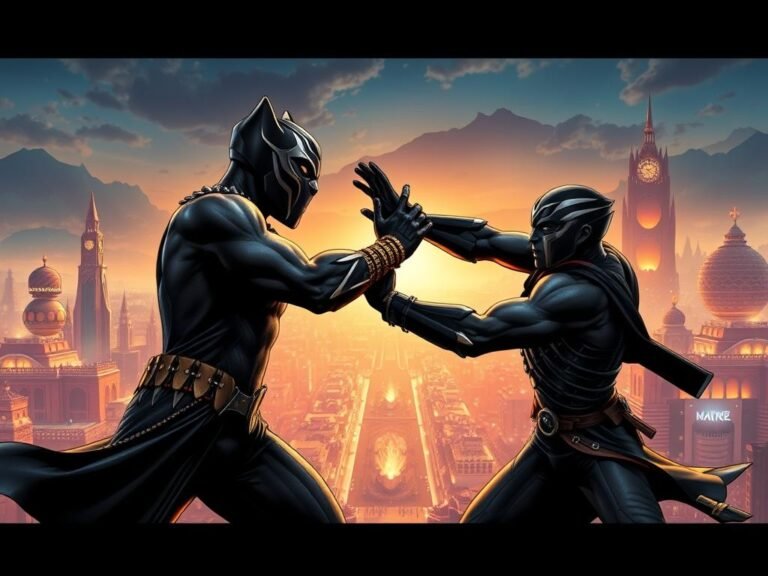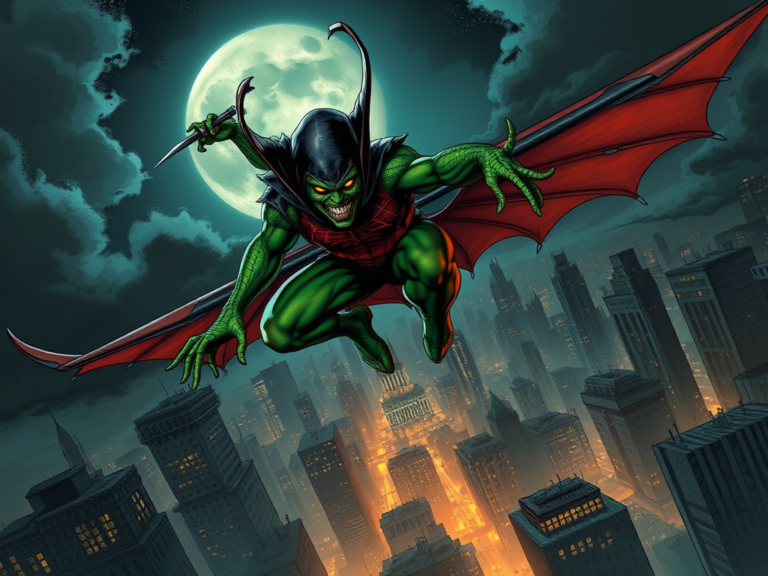Black Panther’s Reign: Leadership and Legacy
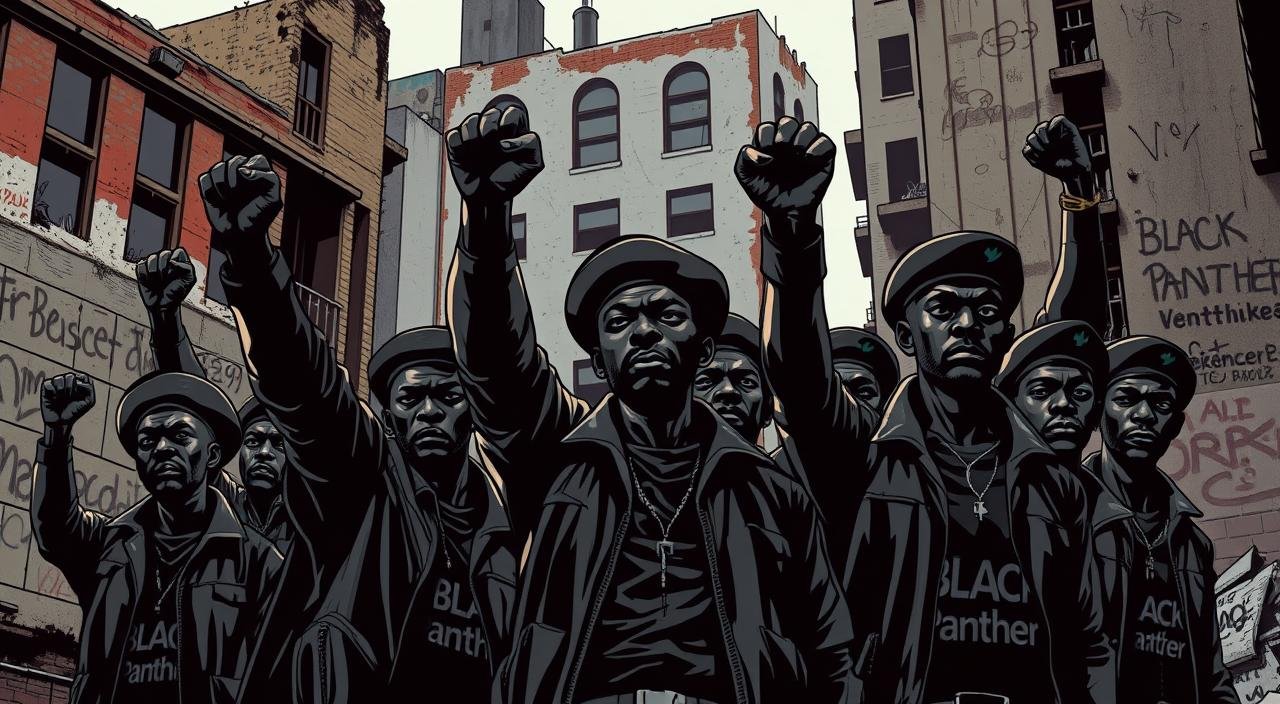
I still remember the powerful image of the Black Panther Party members standing strong against police brutality.
Founded in 1966 by Huey P. Newton and Bobby Seale in Oakland, California, the party emerged as a radical voice during a time of great social change.
The organization initially focused on self-defense, monitoring police activity in African American neighborhoods.
As the party evolved, it developed comprehensive community programs and international chapters, leaving a lasting impact on American society.
Their legacy is complex, marked by both revolutionary ideology and controversy surrounding their militant stance.
The Birth of a Revolutionary Movement
The Black Panther Party emerged as a revolutionary force in the 1960s, shaped by the experiences and ideologies of its founders.
This period was marked by significant social and political upheaval in the United States, with the civil rights movement gaining momentum and African Americans continuing to face systemic racism and oppression.
Historical Context: Post-War America and Civil Rights
Post-war America was characterized by economic prosperity and social change. However, African Americans continued to face significant barriers to equality, including segregation, police brutality, and limited access to education and employment opportunities.
The civil rights movement, led by figures such as Martin Luther King Jr., sought to address these issues through nonviolent means. However, a more radical faction, influenced by the teachings of Malcolm X, began to advocate for armed self-defense and revolutionary change.
This radicalization was partly a response to the ongoing violence and discrimination faced by African Americans. The Black Panther Party would later embody this more militant approach, combining elements of nationalism, socialism, and self-defense.
Founders: Huey P. Newton and Bobby Seale
Huey P. Newton and Bobby Seale, the founders of the Black Panther Party, first met in 1962 while attending Merritt College.
They were both drawn to the Afro-American Association, a group that promoted black nationalism and community empowerment.
Through their involvement with this organization and others, such as the Soul Students Advisory Council and the Revolutionary Action Movement, Newton and Seale developed a revolutionary anti-imperialist perspective.
Newton and Seale’s experiences and readings, influenced by thinkers like Malcolm X, Frantz Fanon, and Mao Zedong, shaped their political philosophy.
A pivotal moment in the formation of the Black Panther Party came when Newton witnessed police brutality in Oakland, leading him to realize the potential of armed self-defense as an organizing tool.
To fund their initial activities, Newton and Seale sold copies of Mao’s Little Red Book to students at Berkeley, demonstrating their pragmatic approach to revolutionary organizing.
Foundational Principles and Ideology
The Black Panther Party’s ideology was multifaceted, incorporating elements of revolutionary nationalism, Marxism, and a strong emphasis on self-defense.
This blend of influences shaped the Party’s approach to addressing the systemic issues faced by African American communities.
The Black Panther Party is perhaps best known for its Ten-Point Program, a document that outlined the organization’s core demands and principles. The program called for freedom, self-determination, and an end to police brutality, among other key issues.
The Ten-Point Program
The Ten-Point Program was a foundational document of the Black Panther Party, detailing the organization’s immediate and long-term goals.
It addressed issues such as freedom, employment, housing, and healthcare, providing a comprehensive framework for the Party’s community programs and political activism.
| Point | Description |
|---|---|
| 1 | Freedom and self-determination for Black people |
| 2 | Full employment for Black people |
| 3 | End to robbery by the white man of the Black community |
Revolutionary Nationalism and Marxist Influences
The Black Panther Party was influenced by revolutionary nationalism and Marxist thought, which shaped their analysis of systemic racism and capitalism. This ideological foundation informed their critique of American society and guided their strategies for social change.

Self-Defense Philosophy
The Black Panther Party’s emphasis on self-defense was a response to the pervasive police brutality and state violence faced by Black communities.
By exercising their legal right to carry arms, the Panthers aimed to protect their communities and challenge the status quo.
The Panthers’ self-defense philosophy was not only a practical response to immediate threats but also a symbolic rejection of the systemic violence perpetuated against African Americans.
This stance distinguished the Party from other civil rights organizations and cultural nationalist groups.
Leadership Structure and Key Figures
Understanding the Black Panther Party requires examining its leadership structure and the key figures who influenced its development and activities. The party’s leadership was not monolithic; it was composed of various individuals with different backgrounds, skills, and areas of focus.
Huey P. Newton: The Visionary Theorist
Huey P. Newton was a founding member and the principal theorist of the Black Panther Party. His ideas about self-defense, community empowerment, and revolutionary nationalism shaped the party’s ideology.
Newton’s leadership was instrumental in defining the party’s stance on armed self-defense and its community survival programs.
Bobby Seale: The Organizational Force
Bobby Seale, along with Newton, co-founded the Black Panther Party. Seale’s organizational skills were crucial in building the party’s structure and mobilizing its members.
He played a key role in the party’s early protests and demonstrations, including the Sacramento Capitol protest.
Eldridge Cleaver: Minister of Information
Eldridge Cleaver served as the Minister of Information for the Black Panther Party. He was a charismatic figure and a prolific writer, whose essays and articles helped to articulate the party’s views and attract new members.
Cleaver’s role was significant in shaping the party’s public image and message.
Elaine Brown: Breaking Gender Barriers
Elaine Brown became the first and only woman to chair the Black Panther Party from 1974 to 1977. Her leadership was marked by efforts to implement community programs and maintain the party’s revolutionary stance during a period of internal crisis.
Brown faced sexist treatment and threats of violence, highlighting the gender dynamics within the party.
The leadership of the Black Panther Party was diverse, with members coming from different walks of life. The party’s structure allowed for various roles and responsibilities, enabling its members to contribute in meaningful ways.
| Leader | Role | Contribution |
|---|---|---|
| Huey P. Newton | Founding Member and Theorist | Defined the party’s ideology and stance on self-defense |
| Bobby Seale | Co-Founder and Organizer | Built the party’s structure and mobilized members |
| Eldridge Cleaver | Minister of Information | Shaped the party’s public image and message |
| Elaine Brown | Chairperson | Led the party during a period of crisis and implemented community programs |

The Black Panther Party’s leadership structure and key figures played a crucial role in shaping the organization’s ideology, actions, and legacy. The diverse backgrounds and contributions of its leaders helped to make the party a significant force in the civil rights movement.
Black Panther’s Reign: Leadership and Legacy in Action
By examining the Black Panther Party’s community programs, we can understand the practical application of their leadership and legacy.
The Black Panther Party was known for its revolutionary ideology, but it was through their community survival programs that they truly put their principles into action.
Community Survival Programs
The Black Panther Party launched more than 35 Survival Programs aimed at addressing the immediate needs of African American communities.
These programs included education, tuberculosis testing, legal aid, transportation assistance, ambulance service, and the manufacture and distribution of free shoes to poor people.
The Black Panther Party’s community programs were designed to be comprehensive, addressing various aspects of community life.
By providing these essential services, the Party aimed to demonstrate that community needs could be met through collective action.
The Black Panther Party’s emphasis on community survival programs reflected their understanding of the interconnectedness of social, economic, and political empowerment.
By meeting basic community needs, they laid the groundwork for more profound social change.
The Free Breakfast for Children Program
One of the most notable initiatives was the Free Breakfast for Children Program, which not only provided nutrition to children in underserved communities but also served as a model for community-based social programs.
This program highlighted the Party’s commitment to addressing the immediate needs of the community, particularly children. The success of this program inspired similar initiatives across the United States.
| Program | Description | Impact |
|---|---|---|
| Free Breakfast for Children | Provided breakfast to children in underserved communities | Nutritional support and model for community programs |
| Liberation Schools | Supplementary education emphasizing Black history and practical skills | Challenged mainstream curricula, centered Black experiences |
| Free Medical Clinics | Provided healthcare services including sickle cell anemia testing | Addressed systemic inequalities in healthcare access |
Education and Healthcare Initiatives
The Black Panther Party also initiated educational programs such as Liberation Schools, which provided supplementary education focusing on Black history, political consciousness, and practical skills.
Additionally, their healthcare initiatives included free medical clinics and sickle cell anemia testing, addressing critical health needs in African American communities.
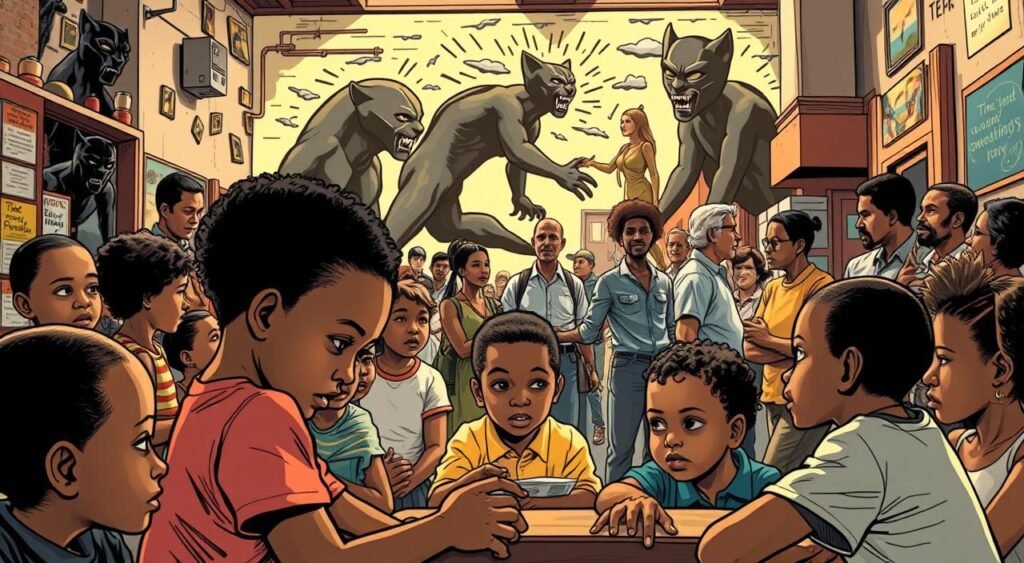
These programs not only addressed systemic inequalities in access to education and healthcare but also embodied the Party’s belief that meeting basic community needs was essential to revolutionary organizing.
By providing these services, the Black Panther Party demonstrated its commitment to the well-being and empowerment of African American communities.
Confronting the System: Tactics and Strategies
Confronting the system was a multifaceted effort for the Black Panther Party, involving armed patrols, protests, and a sophisticated media strategy. This approach allowed the Party to challenge the status quo and push for revolutionary change on multiple fronts.
Armed Patrols and Police Monitoring
The Black Panther Party implemented armed patrols to monitor police activity and protect African American communities from police brutality.
This tactic was a key aspect of their self-defense philosophy, demonstrating the Party’s commitment to protecting its members and the broader community.
- Patrolling African American neighborhoods to observe and document police interactions
- Armed self-defense to deter police brutality and intimidation
- Legal education for community members on their rights during police encounters
The Sacramento Capitol Protest
In May 1967, the Black Panther Party organized a protest at the California State Capitol in Sacramento, where members, some armed, presented a list of demands to lawmakers. This event drew significant media attention and highlighted the Party’s militant stance.
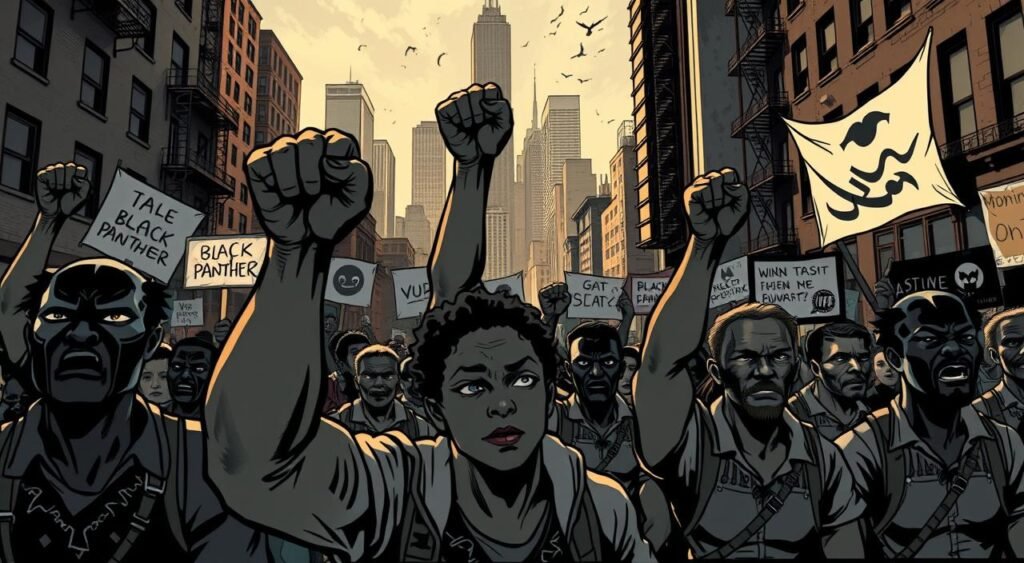
Media Strategy and The Black Panther Newspaper
The Black Panther Party published The Black Panther: Black Community News Service, a newspaper that served as the Party’s primary communication tool. At its peak, the newspaper sold 100,000 copies weekly, connecting chapters across the country and disseminating the Party’s message.
The newspaper’s content included:
- Political education and analysis
- Reports on police brutality and community issues
- Coverage of international revolutionary movements
- Information about community programs and services
The Black Panther newspaper played a crucial role in the Party’s media strategy, allowing them to reach a wide audience and counter mainstream media narratives.
Government Response and COINTELPRO
The FBI, under J. Edgar Hoover’s direction, launched a counterintelligence program aimed at neutralizing the Black Panther Party.
This program, known as COINTELPRO, was a secret operation designed to infiltrate and disrupt the activities of the Black Panther Party and other perceived threats to national security.
FBI Targeting and J. Edgar Hoover’s Campaign
The FBI viewed the Black Panther Party as a significant threat due to its growing popularity and revolutionary ideology.
J. Edgar Hoover personally directed the campaign against the party, labeling it as “the greatest threat to the internal security of the country.”
The FBI’s tactics included surveillance, infiltration, and disinformation campaigns aimed at creating divisions within the party and between the party and other black nationalist groups.
A notable example of the FBI’s aggressive tactics was the raid on the Southern California headquarters of the Black Panther Party in December 1969, which resulted in a five-hour shoot-out with police.
Similarly, an Illinois state police raid led to the killing of Chicago Black Panther leader Fred Hampton.
| Tactic | Description | Impact |
|---|---|---|
| Surveillance | Monitoring of party activities and members | Information gathering for future operations |
| Infiltration | Placement of FBI agents within the party | Internal disruption and intelligence gathering |
| Disinformation | Spread of false information to create distrust | Divisions within the party and with other groups |
Legal Battles and Political Prisoners
The Black Panther Party faced numerous legal challenges as part of the government’s efforts to suppress it. Many members were arrested on various charges, some of which were fabricated.
The party’s leaders, including Huey P. Newton and Bobby Seale, faced lengthy legal battles that drained the party’s resources and morale.
Internal Disruption Tactics
The FBI’s COINTELPRO operations also focused on creating internal conflicts within the Black Panther Party. This was achieved through forged letters, false information, and the use of infiltrators to exacerbate existing tensions.
These tactics contributed to an atmosphere of paranoia within the party, leading to internal security measures that sometimes further damaged trust and cohesion among members.
The combination of external pressure and internal conflict created by COINTELPRO operations significantly contributed to the Black Panther Party’s eventual decline and dissolution.
The aggressive tactics employed by the FBI against the party remain a controversial chapter in American history, highlighting the tension between government power and civil liberties.
Women in the Black Panther Party
Elaine Brown’s leadership marked a significant milestone for women in the Black Panther Party, highlighting the organization’s capacity for gender inclusivity in leadership.
As the first and only woman to lead the Black Panther Party in the 1970s, Brown broke new ground and overcame numerous challenges.
Her appointment was historic, given that among Black-led organizations advocating for civil and human rights at the time, “none had women in leadership except the Black Panther Party,” as Brown herself asserts.
Challenging Sexism Within the Movement
The Black Panther Party was not immune to the sexism prevalent in the broader society. However, the organization’s commitment to equality and the active participation of women helped challenge these biases.
Women like Kathleen Cleaver, Ericka Huggins, and Assata Shakur emerged as prominent leaders, contributing significantly to the party’s ideology and operations.
These women, along with others, played crucial roles in shaping the party’s community programs and communications efforts.
Women Panthers often led the party’s community survival programs, including the Free Breakfast for Children Program, health clinics, and educational initiatives.
Their involvement was instrumental in the success and sustainability of these programs, which were central to the party’s community outreach and support efforts.
Female Leadership and Contributions
The contributions of women to the Black Panther Party extended beyond community programs. They were also integral to the party’s communications and propaganda efforts, including editing The Black Panther newspaper and representing the organization publicly.
Women served as the backbone of local chapters, handling day-to-day operations and maintaining organizational continuity during periods of crisis.
The legacy of women Panthers continues to influence contemporary feminist and Black liberation movements.
Their pioneering work in challenging sexism within the movement and their contributions to the party’s overall mission have left a lasting impact on subsequent generations of activists.
International Impact and Alliances
The Black Panther Party’s influence extended far beyond the United States, establishing a significant international presence.
As a revolutionary organization, they fostered connections with various global movements, creating a network of solidarity that transcended national borders.
Global Chapters and Solidarity
The Black Panther Party successfully established chapters in several countries, including the United Kingdom and Israel.
These international chapters were instrumental in spreading the Party’s message and creating a global movement. Solidarity efforts were a key aspect of their international strategy, with the Party supporting various liberation movements worldwide.
Relationships with Other Revolutionary Movements
The Black Panther Party formed alliances with other revolutionary movements, both domestically and internationally.
They worked closely with white radical groups like the Students for a Democratic Society and the Young Patriots Organization, embodying their class-based analysis.
The Party also had complex relationships with other Black Power organizations, such as the US Organization and the Republic of New Afrika.
| Movement | Relationship | Key Features |
|---|---|---|
| Students for a Democratic Society | Alliance | Shared anti-imperialist goals |
| US Organization | Complex, sometimes conflicting | Differing ideologies on cultural nationalism |
| Young Patriots Organization | Coalition | Multiracial, anti-racist efforts |
The Decline of the Party
The Black Panther Party, once a powerful symbol of Black Power, began to crumble due to internal strife and external pressures. As the party navigated the complexities of the 1970s, it faced numerous challenges that tested its revolutionary ideals.
Fractures Within and External Pressures
Internal conflicts and external pressures played a significant role in the decline of the Black Panther Party.
Support for the party further dwindled due to allegations of criminal activities such as drug dealing and extortion.
The party’s legacy became increasingly controversial, with some historical accounts portraying it as more criminal than political.
According to Joshua Bloom and Waldo Martin, the Black Panther Party was the most influential Black Power organization of the late 1960s, but it eventually collapsed due to infighting, often partly initiated by the government.
The rise of Black elected officials and increased Black political representation within mainstream institutions complicated the party’s revolutionary positioning.
A Changing Political Landscape
As the political landscape of the 1970s shifted away from the revolutionary optimism of the 1960s, the Panther Party faced significant challenges.
The growth of conservatism and law-and-order politics created a hostile environment for revolutionary organizations like the Black Panther.
Economic changes, including deindustrialization and the growth of the drug economy in urban areas, also affected the communities where the party organized.
Over time, the party attempted to adapt to these changing conditions. Huey P. Newton’s pivot toward electoral politics and community development in Oakland was one such attempt.
However, these efforts were not enough to stem the decline of the party, which was ultimately influenced by a combination of factors over the years.
Enduring Legacy in American Society
The Black Panther Party’s legacy continues to influence contemporary social justice movements in profound ways. Their pioneering work in community organizing, self-defense, and social programs has left a lasting impact on American society.
The Black Panther Party’s influence on community organizing models is evident in the way modern organizations structure their efforts.
They pioneered the concept of community-based programs, such as free breakfast initiatives and health clinics, which have been adopted by various social justice movements.
These models have been particularly influential in addressing issues like food insecurity and healthcare disparities in marginalized communities.
Influence on Community Organizing Models
The Black Panther Party’s emphasis on community control and self-determination has shaped the way contemporary organizations approach their work.
For instance, the Black Panther Party’s community programs have inspired modern initiatives focused on community development and empowerment.
Impact on Black Political Consciousness
The Black Panther Party played a crucial role in shaping Black political consciousness in the United States.
Their message of self-empowerment and resistance to systemic racism resonated with many in the Black community, inspiring a new generation of activists.
The Party’s emphasis on Black nationalism and self-defense helped to galvanize a sense of pride and identity among Black Americans.
Connection to Contemporary Movements
The Black Panther Party’s legacy can be seen in contemporary movements like Black Lives Matter, which has drawn inspiration from the Party’s tactics and ideology.
Both movements share a common goal of combating police brutality and systemic racism. The Black Lives Matter movement has adapted the Black Panther Party’s strategies to fit the modern context, using social media and other digital tools to mobilize support and raise awareness about social justice issues.
In conclusion, the Black Panther Party’s influence on American society is still felt today. Their innovative approaches to community organizing and their commitment to social justice have inspired a new generation of activists and continue to shape the landscape of American politics.
Conclusion
The legacy of the Black Panther Party continues to be felt today, with their influence evident in ongoing movements for freedom and self-determination.
Over the years, the Party’s leadership structure and organizational model have been studied for their innovative approach to community empowerment and revolutionary change.
The Black Panther Party made significant contributions to American political thought, particularly in their analysis of the interplay between racism, capitalism, and state violence.
Their work in community survival programs, such as the Free Breakfast for Children Program, demonstrated the potential for community-led initiatives to drive social change.
Historical assessments of the Party have evolved, moving beyond early characterizations to recognize their political significance.
As we reflect on the Panther Party‘s complex legacy, we can identify valuable lessons for contemporary movements.
The Party’s experience highlights the importance of balancing revolutionary ideals with pragmatic organizational strategies.
In the years since the Party’s peak, their influence has endured, inspiring new generations to challenge systemic oppression and fight for power and justice.
As we look to the future, the story of the Black Panthers serves as a powerful reminder of the impact that dedicated people can have when they come together as a cohesive organization.
FAQ
What was the main goal of the Black Panther Party?
The main goal was to achieve liberation and self-determination for African Americans through community empowerment and challenging systemic racism.
Who were the founders of the Black Panther Party?
The party was founded by Huey P. Newton and Bobby Seale in 1966, driven by their vision for a more just and equitable society.
What was the significance of the Free Breakfast for Children Program?
This program was a cornerstone of the party’s community survival initiatives, providing essential nutrition to children and demonstrating the party’s commitment to serving the community.
How did the FBI respond to the Black Panther Party’s activities?
Under the direction of FBI Director J. Edgar Hoover, the FBI launched COINTELPRO, a campaign aimed at disrupting and dismantling the party through various tactics, including surveillance and infiltration.
What role did women play in the Black Panther Party?
Women, such as Elaine Brown, played crucial roles in the party, challenging sexism and contributing to its leadership, organizing, and community programs.
How did the Black Panther Party influence contemporary social movements?
The party’s emphasis on community organizing, self-defense, and challenging systemic racism has influenced movements such as Black Lives Matter, shaping the way activists approach issues of justice and equality.
What was the Ten-Point Program?
The Ten-Point Program was a foundational document outlining the party’s demands, including freedom, justice, and economic empowerment for African Americans.
How did the Black Panther Party engage with other revolutionary movements?
The party formed alliances and expressed solidarity with other revolutionary movements globally, recognizing the shared struggle against oppression and imperialism.

